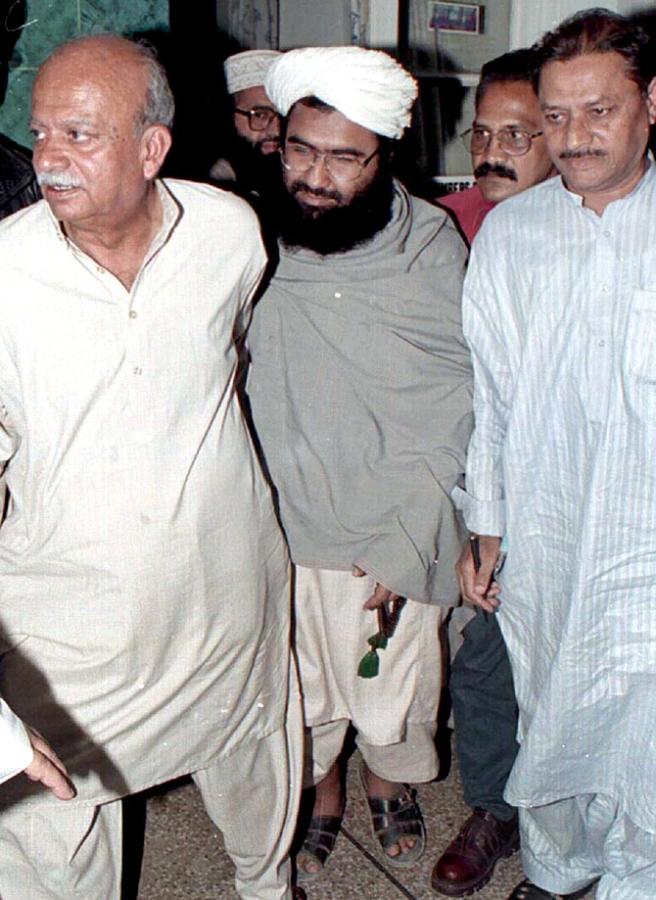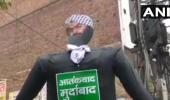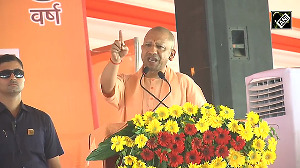The Pakistan army's Bahawalpur Corps has always had a special significance for India as it keeps an eye on the Jaish e Mohammed, explains Rana Banerji, who headed the Pakistan desk at RA&W.

He had been freed from an Indian prison along with two other terrorists in exchange for the passengers and crew of the hijacked Indian Airlines flight IC-814. Photograph: Reuters
Lieutenant General Saqib Mehmood Malik, 14 Punjab (79th PMA course, Kakul) was due to retire on April 3, 2025 as the 24th corps commander of the XXXI Corps, Bahawalpur, having taken over on December 4, 2022 from his now rather 'infamous' predecessor, Lieutenant General Faiz Hameed.
In a pattern familiar to Pakistan army chief General Asim Munir's style of managing reshuffles of his senior generals, no decision on filling up the vacancy has been made public so far.
Saqib Mehmood served as a brigadier in the Northern Areas during the Gyari avalanche in April 2012 when 140 soldiers at an army base in the Gyari sector, Ghianche district, Gilgit Baltistan, opposite Siachen in Jammu and Kashmir, were trapped under heavy snow, leading ultimately to 129 soldiers killed along with 11 civilians (contractors and labour).
He was thereafter posted as the defence attache in Pakistan's high commission in New Delhi (2013 to 2016).
Picking up two star rank on return (major general), he served as Force Commander, Northern Areas under X Corps, Rawalpindi, taking over from General Asim Munir there, when the latter was appointed director general military intelligence.
Promoted to three star rank in April 2021, Lieutenant General Saqib became chief of logistics at General Headquarters before being posted to the Bahawalpur Corps command.
The Bahawalpur Corps was set up in 1986, bifurcating assets and responsibilities earlier part of II Corps, Multan.
It presently oversees three Infantry Divisions (35 and 14 Infantry, 26th Mechanised Infantry) and five independent brigades (one each of infantry, artillery, armoured corps, signals and engineering) with responsibilities of defensive and offensive warfare covering he desert regions of southern Punjab, where it can also have a role to assist civilian authority in anti-dacoity operations, in the 'kutcha' areas of Rahim Yar Khan and Rajanpur.
Though considered a somewhat 'backwater' assignment in the peer parlance of military professionals in Pakistan, the Bahawalpur corps assignment has always had a special significance for India as it keeps an eye on the sprawling, indeed ever burgeoning, headquarters of the Jaish e Mohammed whose campus in Bahawalpur has served as home for the terrorist Masood Azhar and his brothers, focusing on State sponsored terror activities in Jammu and Kashmir.
After his health failed, Masood Azhar may have been whisked away to army guarded safer confines closer to Rawalpindi but his brother Abdul Rauf Azhar and other family members/senior Jaish leaders continue to frequent the Bahawalpur premises under the military's benevolently watchful eye.

Lieutenant General Saqib could be replaced on promotion by either Major General Akim Iqbal, 37 Punjab, 84th PMA, currently director general, counter-terrorism at the Inter Services Intelligence Directorate (ISI) or Major General Muhammed Irfan, 39 Punjab, GOC 12 Division, Muree, both straining to pick up rank in the seniority pecking order of two star generals.
Akim's placement there, with his recent ISI experience, could certainly be worrisome from the point of view of India's concerns.
If newly promoted officers are not to be sent straight away to a corps command, General Munir could consider placing one of the more senior lieutenant generals from the 82 PMA long course like Lieutenant General Amer Ahsan Nawaz, 3 Baloch Regiment, currently military secretary or Lieutenant General Sarfraz Ahmed, Air Defence, currently inspector general, Arms at GHQ, to the vacant Bahawalpur Corps Command.
However, a military secretary is usually a close and trusted aide of the army ghief and if General Asim Munir considers going for a larger reshuffle at this stage, Lieutenant General Amer Ahsan Nawaz could well be considered for posting to XII Corps, Quetta, Baluchistan, where Lieutenant General Rahat Naseem Ahmed Khan, 1 Frontier Force Regiment, has been corps commander for nearly two-and-a-half years.
After the recent uptick in terrorist activity in the province, Baluchistan needs perhaps renewed energy and new leadership initiatives at the operational level.
No other retirements of lieutenant generals are immediately due in Pakistan after this change.
The next set is slated to occur in late November 2025 if at all.
After the November 2024 amendment to the Pakistan Army Act, 1952, General Munir is likely to continue as army chief for a five year term, which will now end in November, 2027.
However, General Sahir Shamshad Mirza's term as chairman, joint chiefs of staff committee, will conclude in November 2025, leaving scope for elevation of one three star general to the vacant four star slot.
Lieutenant General Asim Malik, currently director general ISI, was promoted as lieutenant general in 2021, almost a year ahead of his 80th PMA Kakul course-mates.
He will complete four years in the rank of lieutenant general in October 2025 thus becoming due for retirement.
Whether that happens or not is a different question as by all accounts, he seems to have made himself indispensible in loyal service of his master, General Munir.
He could emerge as a major contender for elevation then to the other, albeit largely ceremonial, four star slot of general.
He may have to compete with another loyalist, Lieutenant General Shahid Imtiaz, 19 Azad Kashmir Regiment, an officer from the Officer Training School stream, whom General Munir brought in as X Corps Commander, Rawalpindi immediately after becoming army chief in November, 2022, reversing overnight General Qamar Javed Bajwa's decision to appoint Lieutenant General Nauman Zakaria, now corps commander, 1 Corps, Mangla to that post.
Lieutenant General Shahid Imtiaz has remained in the crucial Rawalpindi slot ever since.
Feature Presentation: Ashish Narsale/Rediff











 © 2025
© 2025